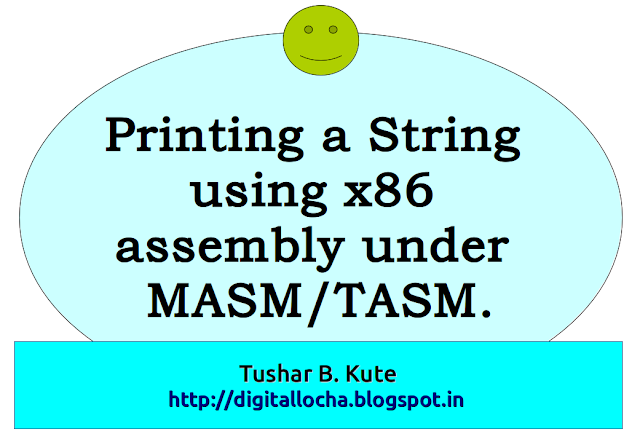String
is an array of character, where all character are stored in
contiguous fashion. In computer's view, string is an array of bytes
stored in contiguous memory. Here, I have used term 'byte' because
computer does not recognize integer and character separately. It
knows only bytes.
To
print a string, we need an array of bytes or character stored in a
memory with a 'end of string' character. Let's see how it is done.
Generally,the
array are stored in a data segment.For example,
.data
char
db 'a','b','c','d','$'
Here,
'char' is the name of array variable. These characters will get
stored in contiguous memory locations with values 'abcd'. The '$' is
end of string character. It recognizes that there are no more
characters after it. It is compulsory to have '$' as the end of
string characters for all strings. As I already told, computer only
knows bytes, following declaration of string is also similar to
previous one.
.data
char
db 41,42,43,44,'$'
Here,
41, 42, 43 & 44 are ASCII values of 'abcd' respectively. In order
to print a string on screen x86 architecture uses DOS interrupt
number 21H with function number 09H. So,
INT
21H & AH=09H
will
do the task for us.
Before
this, we must store offset address/effective address of the string in
data register (DX). Address of string or address of first character
of string must be stored in DX register, function 09H gets this
address from DX and print the characters on the screen from first
byte till '$'.
Following
code will print 'welcome' on screen.
.DATA
MESSAGE
DB 'WELCOME$'
.CODE
MOV
DX, @DATA
MOV
DS, AX
LEA
DX, MESSAGE
MOV
AH, 09H
INT
21H
MOV
AH, 4CH
INT
21H
END
The
instruction 'LEA' loads the offset of effective address of variable
'MESSAGE' in DX register. Remember, it is mandatory to have '$' at
the end!
You
may try by removing '$' from the string.

"I very much enjoyed this article.Nice article thanks for given this information. i hope it useful to many pepole.php jobs in hyderabad.
ReplyDelete"
Four Segment Pipeline
ReplyDeleteAnalysis-Synthesis model of compilation
AES Key Expansion
Data Flow Properties
Projections
Advanced Features of FLWOR with Example
Language Processor Development Tools
Designing issues Thread package
Transformation
Multiplication Operation
ReplyDeleteSelf-Learning Properties of Link Layer Switches
Projections: Perspective Projection
Characteristics software
Problem Characteristic
TDMA: Time Division Multiple Access
Thread modes
Address Mapping using Pages
Switching Techniques: Packet Switching
should MOV DX, @DATA read
ReplyDeleteMOV AX, @DATA